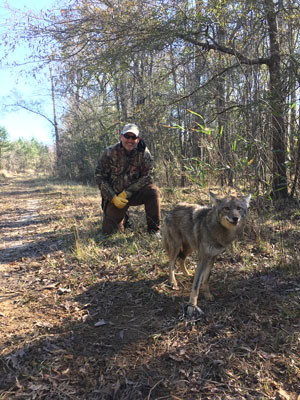
Catching unwelcome wildlife comes naturally to a local trapper.
Tracking coyotes, grappling with alligators or having a snake land on your head after it falls out of a tree might be disconcerting to most people. For Dan Eaton of Evans, it’s all in a day’s work.
For more than 25 years, he has owned and operated CSRA Trapping Services to conduct the humane removal of unwanted wildlife from properties. He started the business after a local farmer called him and asked him to trap beavers on his property because they were keeping him from moving his cows from one pasture to another.
“I said I would do it in a couple of months, but the farmer said he would pay me if I did it then,” Eaton says.
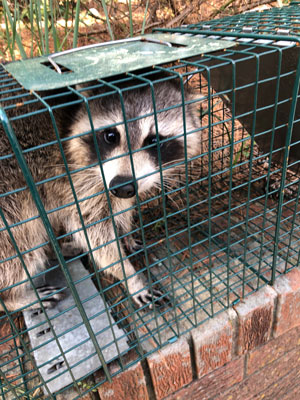 Bats & Birds, Squirrels & Snakes
Bats & Birds, Squirrels & Snakes
The job is a natural for Eaton, who has been trapping animals since he was 10 years old. Growing up on a farm in southern Illinois in the 1970s, he trapped minks, muskrats and raccoons.
“When you’re only 10 years old, you have to trap the animals you find around ponds and creeks,” says Eaton, whose uncle taught him how to trap.
Now, he traps animals such as coyotes, alligators, snakes, foxes, raccoons, possums, squirrels, bats and birds with his business that is licensed by the Department of Natural Resources in Georgia and in South Carolina.
“If it walks, crawls, flies or swims, and you’ve got ’em, we get ’em,” says Eaton.
During his career, Eaton has been bitten by frightened or angry critters only a couple of times. Of course, he has a foolproof way to protect himself from bites. “I don’t put my hand in the animal’s mouth,” he says.
He uses various tools of the trade such as cages, foothold traps (which have no sharp edges), choke sticks and snake tongs to humanely snare wildlife. He reaches into crawl spaces with a claw to catch uninvited animals. Under regulations, Eaton has to check his traps every 24 hours. He takes care of the animals based on state requirements, which can range from euthanizing to relocating the animal.
According to Eaton, people’s reaction to wildlife should depend on where the animal is and what it is doing.
“If you see an animal in your yard, it doesn’t necessarily mean it’s living there. It could just be passing through,” he says.
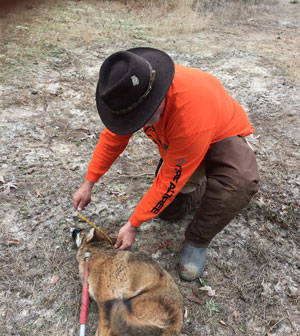 Wily Coyotes
Wily Coyotes
From 2014 until 2016, Eaton was part of three-year University of Georgia study to understand how coyotes thrive in the South, and how they differ from those in the North and West.
He trapped about 75 coyotes altogether, and he had to weigh, measure, photograph the teeth and put a GPS tracking collar on each of them.
Biologists also took DNA and blood samples from the animals, and the scientists hoped to learn how coyotes navigate agricultural fields and woods and how they hunt.
The technology allowed researchers to follow the movements of the coyotes to see how they dispersed and populated new areas. Biologists also hoped to develop management strategies to reduce coyote populations by gaining an understanding of their movements and patterns.
The ability to monitor so many animals simultaneously shed light on coyote behavior and identified traits of resident coyotes, which exhibit strong allegiance to areas, and transient coyotes, which have nomadic tendencies.
Eaton says it’s a challenge to trap coyotes. For the study he used beaver-based bait to entice them to put a paw in a 3.5-inch, circular foothold that was buried underground in a 100-acre area.
“They’re pretty smart. They’re harder to catch. Everything else is pretty easy. Coyotes learn, and I learn from them,” says Eaton. “They’re survivors. Just when you think you have something figured out, they do something different.”
Coyotes are also a concern in suburban areas, where they can prey on small pets, and Eaton finds it particularly gratifying to catch predator animals. “Coyotes are the apex predator in Georgia,” he says.
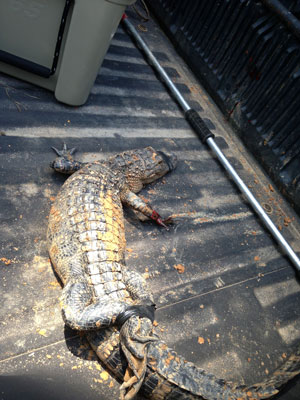 Later, Gator
Later, Gator
Coyotes might be wily, crafty creatures, but alligators, well, not so much.
“Their brain is the size of a golf ball,” Eaton says. “They’re not smart.”
Not that it’s effortless to trap a gator, though. This summer Eaton caught a 4-foot alligator that was taking a dip in a pool at a Burke County home. “He didn’t want to come out of the pool,” says Eaton.
He had to guide the gator to the shallow end of the pool with a long-handled skimmer and pull it out with a catch pole. After taping the alligator’s mouth and legs together, he put it in the back of his truck and released it in the Savannah River.
“You can tape alligators’ mouths shut with two fingers,” says Eaton. “They don’t have any strength when they open their mouth. It’s all when they close it.”
Another alligator that he recently caught in a residential pond in Louisville required different tactics. “We had to wear him out first,” Eaton says.
The trapper got in a boat, caught the 3-foot alligator with a fishing pole and let him pull the boat around until he was exhausted. Eaton released this gator into the Ogeechee River.
He even caught an alligator in downtown Augusta by throwing a towel over its head and jumping on its back.
 Fear Factor (Or Lack Thereof)
Fear Factor (Or Lack Thereof)
However, the call he dreads the most is the one to trap moles. Not because of anything the little varmints do, however. “It’s not a quick fix, and everybody wants a quick fix,” Eaton says.
So far, his most unusual task has been capturing a red-tail boa constrictor that was a one-snake welcome committee for new homeowners who found it after moving into their house. The boa had belonged to the college-aged son of the previous owners. His parents thought he had taken the snake to college with him, but it actually had escaped from its aquarium – much to the chagrin of the new residents.
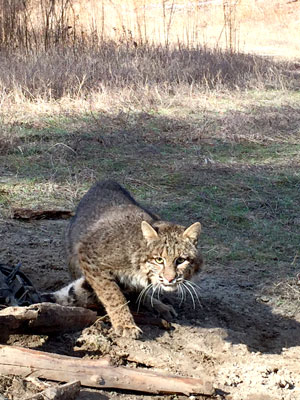 Eaton’s biggest fear on the job comes, not from the animals, but from the possibility of falling off of a roof or a ladder. He took a 40-foot fall from a rooftop about three years ago when he was trying to trap bats. He had to have shoulder surgery as a result of the fall, but he still caught the bats.
Eaton’s biggest fear on the job comes, not from the animals, but from the possibility of falling off of a roof or a ladder. He took a 40-foot fall from a rooftop about three years ago when he was trying to trap bats. He had to have shoulder surgery as a result of the fall, but he still caught the bats.
Largely self-taught, Eaton is a member of the National Wildlife Control Operators Association, and he has taken certification classes through the organization. He is a member of the Georgia Trappers Association, and he has a good relationship with the state Department of Natural Resources.
“I have learned a lot from other people, and I have taken classes and seminars through associations,” he says.
Since animals tend to appear on their own time, trapping them is not a 9-to-5 vocation. And it’s no wonder Eaton has no qualms about tangling with wildlife for a living. After all, he spends his spare time jumping out of airplanes and teaching freefall and tandem skydiving lessons.
“I’m not smart enough to be scared,” says Eaton. “Nothing surprises me anymore. I expect the unexpected.”
Anytime, anywhere.
“I got bitten by a copperhead once and had to go to the hospital, and I wasn’t even on the job,” he says. “I was picking up wood in my own backyard.”
As for any snake that freefalls on top of him out of trees in the woods, he has a matter-of-fact method of slithering out of its path. “I grab the snake and throw it one way,” Eaton says, “and I go the other way.”
By Todd Beck